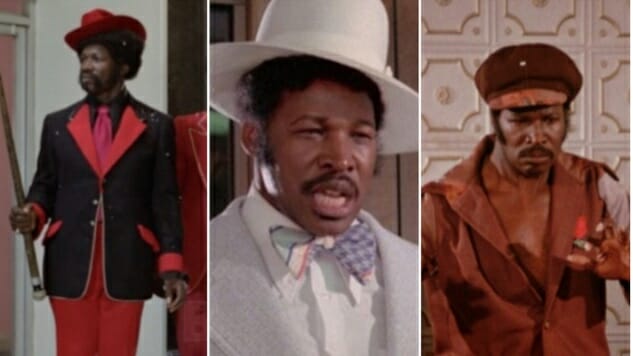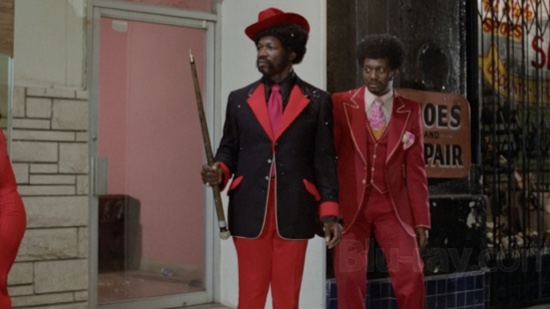Rudy Ray Moore Is His Name: A Primer on the Man Behind Dolemite

Late in Netflix’s Dolemite Is My Name, a loving biopic about plucky underdog filmmaking written by the masters of loving biopics about plucky underdog filmmakers Scott Alexander and Larry Karaszewski (Ed Wood), underground comedy phenomenon Rudy Ray Moore (Eddie Murphy in a dynamite comeback role) is ecstatic that he can finally share his no-budget movie Dolemite with his audience. While one of the many technically inept but uproariously bizarre and entertaining sequences roll on the big screen, the theater owner (Barry Shabaka Henley) asks Moore what his film’s supposed to be—action, comedy, awkward martial arts? Moore answers with the twinkle-in-your-eye enthusiasm that only Murphy can pull off without a hint of irony: “It’s a comedy, and it’s sexy, and it’s action. It’s a total entertainment experience.”
Moore’s obsession with entertaining his audience by any means necessary, budgetary and technical restraints—or any tonal cohesion, for that matter—be damned, is what makes his work stand out and endure amongst ’70s blaxploitation history. Film buffs can appreciate the social significance of some blaxploitation classics, but how often do we have the desire to sit through them without the goal of grasping their historical context? Sweet Sweetback’s Baadasssss Song may be vital landmark for the genre, but it’s borderline unwatchable today due to its didactic and episodic structure as well as its suffocating art-house aesthetic. Yet pop in a Rudy Ray Moore vehicle and you’re bound to have a good time, despite, and sometimes due to, the technical shortcomings and the persistently crass content. So to better prepare yourself for Dolemite Is My Name and to laugh your ass off in the process, put your weight on it and watch these four Moore flicks.
Dolemite (1975)

After becoming an underground hit with his comedy records where Moore took on the persona of Dolemite, a cocksure pimp and a badass pussy magnet who roasts his enemies in rhyme, he set his sights on the silver screen after realizing that there were not many black comedy voices in movies. In keeping with his brand of blind ambition and fearless self-confidence, he gathered his friends and colleagues, none of whom had any experience in filmmaking, and set out to make his first feature with almost a nonexistent budget. This, at a time when filmmaking required a hell of a lot more money and expertise than grabbing a consumer DSLR camera and a Final Cut Pro license.
The technical outcome is predictably terrible, and adds oodles to Dolemite’s charm as a so-bad-it’s-good blaxploitation staple. The awkward framing, stiff acting, lethargic editing, cheap production design, and over-the-top infallibility of the protagonist have provided endless inspiration for blaxploitation parodies over the decades, from Aries Spiers’ Dolemite skits on Mad TV to the underrated 2010 comedy Black Dynamite. A lot of the jabs at the film’s technical ineptitude are on point, with one exception: It’s always made fun of for having boom mics appear on top of the frame. This particular “goof” is not the film’s fault—the fault of exhibitors who didn’t mask the aspect ratio properly when the print was shown in grindhouse theaters.
What makes Dolemite different from the likes of The Room or Plan 9 from Outer Space is that Moore is always in on the joke. He doesn’t care if we laugh at him or with him; everything’s fine as long as we’re having fun. The shoestring plot of Dolemite getting out of prison and exacting sweet revenge on the cops and competitors who framed him is used as an excuse to string together as many rhyming jokes, kung-fu fights by a pudgy middle-aged man who had zero martial arts training, and lots and lots of naked breasts.
There’s also of course the added power fantasy of black audiences seeing a black man on the big screen punishing white villains in increasingly violent and creative ways, such as the iconic sequence where Dolemite makes a white villain dance by shooting at his legs, before killing that “rat-soup-eating motherfucker” in cold blood. (I think we should all make “Rat-soup-eating motherfucker” a go-to burn from now on.)
-

-

-

-

-

-

-

-

-

-

-

-

-

-

-

-

-

-

-

-

-

-

-

-

-

-

-

-

-

-

-

-

-

-

-

-

-

-

-

-











































